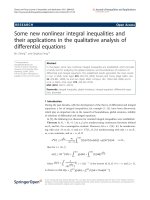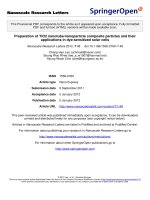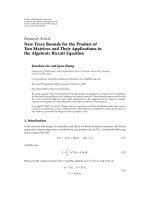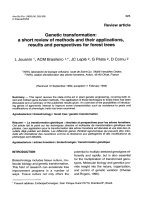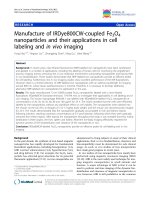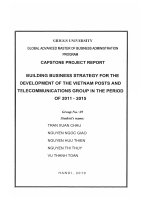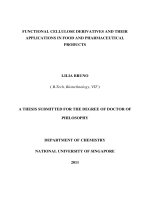Development of mesh free methods and their applications in computational fluid dynamics
Bạn đang xem bản rút gọn của tài liệu. Xem và tải ngay bản đầy đủ của tài liệu tại đây (16.99 MB, 273 trang )
DEVELOPMENT OF MESH-FREE METHODS AND THEIR
APPLICATIONS IN COMPUTATIONAL FLUID DYNAMICS
DING HANG
NATIONAL UNIVERSITY OF SINGAPORE
2004
DEVELOPMENT OF MESH-FREE METHODS AND THEIR
APPLICATIONS IN COMPUTATIONAL FLUID DYNAMICS
DING HANG
(B. Eng., M. Eng.)
A THESIS SUBMITTED
FOR THE DEGREE OF DOCTOR OF PHILOSOPHY
DEPARTMENT OF MECHANICAL ENGINEERING
NATIONAL UNIVERSITY OF SINGAPORE
2004
I
Acknowledgements
I would like to express my deepest gratitude and thank to my supervisors A/P C. Shu
and K. S. Yeo for their invaluable guidance, encouragement and patience throughout
this study.
Thanks also go to the friends and staff of the Fluid Mechanics Laboratory in NUS for
their help and excellent service.
My gratitude also extends to my wife and my families for their support and
encouragement in all the way.
Finally, I wish to thank the National University of Singapore for providing me with
the research scholarship, which makes this study possible.
Ding Hang
II
Table of Contents
Acknowledgement… …………………………………………………………… I
Table of Contents ………………………………………………………………… II
List of Figures……………………………………………………………………….X
List of Tables………………………………………………………………………XVI
Nomenclature …………………………………………………………………XVX
Summary ….…………………………………………………………………… XXIII
Chapter 1 Introduction ………………………………………….…………… 1
1.1 Background of computational fluid dynamics …………………………………1
1.1.1 Analytical solution of PDEs ……………………………………………… 1
1.1.2 Numerical solution of PDEs…………………………………………………1
1.2 Why mesh-free……………………………………………………………………4
1.2.1 Dynamic complexity of flow problems ……………………………… 4
1.2.2 Geometrical complexity of flow problems…………………………………4
1.2.3 Concept of mesh-free ………………………………………………………6
1.3 Literature review ……………………………………………………………… 7
1.3.1 Classification of mesh-free methods …………………………………… 8
1.3.2 Mesh-free methods of integral type …………………………………………9
1.3.2.1 Smoothed particle hydrodynamics (SPH) method ……… ………10
1.3.2.2 Diffuse element (DE) and Element-free Galerkin (EFG) methods
.……….…………………………………………………………………… 10
1.3.2.3 Meshless local Petrov-Galerkin (MLPG) method …………………11
1.3.3 Mesh-free methods of non-integral type …………………………………12
III
1.3.3.1 Drawbacks of mesh-free methods of integral type in the flow
simulations ………………………………………………… ………12
1.3.3.2 General finite difference (GFD) method ………….………….……13
1.3.3.3 Multiquadric (MQ) method ………………………………………14
1.4 Desirable mesh-free methods for fluid simulations ……………………………16
1.5 Objective of this thesis …………………………………………………………16
1.6 Organization of this thesis …….……………………………………………….17
Chapter 2 Least Square-Based Finite Difference Method ……………20
2.1 Conventional finite difference scheme ………………………………………20
2.1.1 FD’s limitation in complex geometry ………………………… 20
2.1.2 Motivation of constructing FD-like mesh-free method ….21
2.2 Least square-based finite difference method …………………22
2.2.1 Two-dimensional Taylor series formulation ………………………… 22
2.2.2 Local support scaling ……………….25
2.2.3 Least square technique ……………….27
2.2.4 Weighting function ……………….29
2.3 Theoretical analysis of discretization error … …………………………………31
2.4 Numerical analysis of convergence rate ……………………………………34
2.5 Concluding remarks ……………………………………………………… 38
Chapter 3 Local Radial Function-based Differential Quadrature
(LRBFDQ) Method
… 39
3.1 Radial Basis Function (RBF) and its interpolation scheme ….………………….39
3.2 Traditional RBF-based schemes and their weakness …………………………42
IV
3.3 Development of Local Radial Basis Function-based Differential Quadrature
Method method ………………………………………………………………………45
3.3.1 Traditional Differential Quadrature (DQ) Method … ……………………46
3.3.2 Formulation of local MQ-DQ Method …… ……………………………47
3.3.3 Normalization of shape parameter ……… ….……………………………51
3.4 Sample problems ………… ….…………………… ….……………………… 53
3.4.1 Poisson equation ……………….………….…………………………….…53
3.4.2 Advection-diffusion equation … ………….………………………………55
3.5 Empirical error estimate for LMQDQ method …………………………………57
3.5.1 Review of accuracy analysis of RBF-related numerical schemes …………57
3.5.2 Empirical analysis of discretization error for LMQDQ method …………58
3.5.3 Numerical Results for individual factor ………………………… ………60
3.5.3.1 Mesh size h ……………………………………………… ………60
3.5.3.2 Shape parameter c ……………………………………… ………62
3.5.3.3 Number of supporting points …………………….……… ………64
3.5.4 Relationships between numerical error and three factors …………………66
3.5.4.1 Dependence of numerical error on shape parameter and mesh size
…………….….…………….….…………………………….….…………66
3.5.4.2 Relationship between numerical error, mesh size and number of
supporting points ….….…………….……………………….… ………68
3.5.4.3 Relationship between numerical error, shape parameter and number
of supporting points ………………………………………………………71
3.6 Concluding remarks ………………………………………………………… 73
V
Chapter 4 Navier-Stokes Equations, Node Generation Algorithm and
Solution Method
…………………………………………………75
4.1 Basic equations of fluid dynamics in Eulerian form…………….….……………76
4.1.1 Compressible Euler equations ….………………………………………….76
4.1.2 Incompressible Navier-Stokes equations ……………….…………………79
4.2 Node generation algorithms …………………………………………………… 82
4.2.1 Mesh generation versus node generation ………………………………….82
4.2.2 Composite “gird” algorithm ….……………………………………………83
4.2.3 Cartesian node generator ……………………………….………………….84
4.2.4 Random node generator ……………………………………………………85
4.2.5 Locally orthogonal grid ……………………………….………………… 86
4.3 Determination of local support ………………………………………………… 89
4.4 Solution method …………………………………………………………………90
4.2.1 Steady flows ……………………………………………………………….90
4.2.2 Unsteady flows ……………….……………………………………………91
4.5 Concluding remarks ……………………………………………………………92
Chapter 5 Applications to Steady Incompressible Flows .…………… 93
5.1 Natural convection flow in a square cavity…………………………………… 93
5.1.1 Mathematical modeling and numerical discretization ……………… …. 93
5.1.2 Three types of node distributions and comparison of numerical results ….97
5.2 Natural convection between a square outer cylinder and a circular inner cylinder
…………………….….…………….….………………………………………101
5.2.1 Mathematical modeling …………………………….….…………… ….102
5.2.2 Pressure single-value condition …………………….….…………… ….103
VI
5.2.3 Definition of configuration and flow parameters ……………………… 105
5.2.3.1 Configuration parameters and “grid” size ……………………… 105
5.2.3.2 Nusselt numbers ….………….………………………………106
5.2.4 Grid-independent study ……………………………….…….……… ….107
5.2.5 Validation of numerical results … ……………………………………108
5.2.6 Global circulation ……………………………………………………….109
5.2.7 Analysis of flow and thermal fields ……………………….….….………112
5.3 Three-dimensional lid-driven cavity flow ………………………….…….…….119
5.3.1 Fractional step method ……………………………….….……….…… 120
5.3.2 Geometry configuration and physical boundary conditions …….……….123
5.3.3 Solution procedure and comparison of numerical results ……….……… 127
5.4 Concluding remarks ………………………………………………………….135
Chapter 6 Applications to Unsteady Incompressible Flows ………136
6.1 Review of study for flow around circular cylinders ……………………………136
6.1.1 Experimental study of flow around two circular cylinders ………………137
6.1.2 Numerical study of flow around two circular cylinders ……………….…138
6.2 Scope and objective of cylinder flow study ……………………………………140
6.3 Governing equations, boundary and initial conditions …………………………141
6.3.1 Governing equations for unsteady incompressible flow …………………141
6.3.2 Boundary conditions ………………….………………………………… 142
6.3.3 Initial conditions …………………… …………………………….…….143
6.4 Numerical solutions for flow around two circular cylinders ….….….…………143
6.4.1 Definition of flow parameters ……………………………………………144
6.4.1.1 Lift and drag coefficients (
L
C &
D
C ) ….…………………………144
VII
6.4.1.2 Strouhal number (St) ….………….………………………………145
6.4.2 Side-by-side arrangement …………….………………………………… 145
6.4.2.1 Biased flow pattern ….……………………………………………146
6.4.2.2 Synchronized Karman vortex streets ….………….………………147
6.4.2.3 Validation of flow parameters ……………………………………148
6.4.3 Tandem arrangement …………….……… ……………………….…….149
6.4.3.1 Quasi-steady attachment ….………………………………………149
6.4.3.2 “Lock-in” phenomenon between two cylinders………….….……150
6.4.3.3 Validation of flow parameters ……………………………………151
6.4.4 Staggered arrangement …….…….……… ……………………….…….153
6.4.5 Effects of Reynolds number …….…….……… ………………….…….154
6.5 Concluding remarks………………………………… ……………….…….155
Chapter 7 Applications to Compressible Inviscid Flows ……………172
7.1 Review of mesh-free methods fro compressible flow simulation ……………172
7.2 Mesh-free Euler solver …………………………………………………………173
7.2.1 Weakness of mesh-free method in the compressible flow simulation … 173
7.2.2 Euler equations in the conservative form ………………………………174
7.2.3 New flux
ki,
G ……………………………………………………………176
7.2.4 Artificial dissipation………………………………………………………177
7.2.5 Evaluation of new flux by Roe’s scheme and limiter ……………………178
7.2.6 Comparison between the upwind mesh-free scheme and finite volume
method ……………………………………………………………………182
7.2.7 Boundary conditions for invicid flow ……………………………………184
7.3 Numerical examples and discussion ……………………………………………186
VIII
7.3.1 Two-dimensional supersonic flow in a symmetric convergent channel …186
7.3.2 Shock tube problem ………………….………………………………… 190
7.4 Concluding remarks………………………………… ……………….…….197
Chapter 8 Hybrid Finite Difference and Mesh-free Scheme ………199
8.1 Benefits and drawbacks of using mesh-free methods ……………….…………199
8.2 How to handle complex geometry effectively and efficiently …………………201
8.2.1 Cartesian mesh method …………………….…………….………………201
8.2.2 Overset mesh method ………………….…………………………………202
8.2.3 Motivation of using hybrid method ………………………………………202
8.3 Hybrid FD and Mesh-free Method …….….……………………………………203
8.3.1 Methodology ………………………………………….…….……………203
8.3.2 Information Exchange layer …………….……………………………… 204
8.4 Numerical examples for validation …… ….………….….……………………206
8.4.1 Flow past one isolated circular cylinder …………………….……………206
8.4.1.1 Geometry description ….…………………………………………207
8.4.1.2 Mesh design ….…….….….………………………………………208
8.4.2 Results and Discussion …………….…………………………………… 209
8.4.2.1 Effect on efficient improvement …………………………………210
8.4.2.2 Steady flow simulation at low Reynolds numbers ………….……211
8.4.2.3 Unsteady flow simulation at medium Reynolds numbers ….….…213
8.5 Concluding remarks………………………………… ……………….…….215
Chapter 9 Conclusions and Recommendations ………………………221
9.1 Similarity and difference …………………….…………………………………221
IX
9.2 Numerical experiments …………………….…………………………………222
9.2.1 Poisson equation ……………………….………………….……………222
9.2.2 Lid-driven cavity flow ……………………………………………………226
9.3 Concluding remarks………………………………… ……………….…….232
Chapter 10 Conclusions and Recommendations ………………………233
10.1 Conclusions …………….……….………….…………………………………233
10.2 Recommendations on future work ……………………………………………236
References………………………………………………………………………….237
X
List of Figures
Figure 2.1 Supporting knots around a reference knot …….………….…………… 22
Figure 2.2 Convergence curves of LSFD with different weighting functions ………37
Figure 2.3 Convergence curves of LSFD and central-difference FD Schemes … …38
Figure 3.1 Irregular knot distribution for solution of sample PDEs ……………… 54
Figure 3.2 Log
10
(error) vs
2
c with irregular knot distribution for Poisson
problem………………………………………………………………… 55
Figure 3.3 Perspective view of solution functions………….….…………………….60
Figure 3.4 Convergence rate of relative error versus mesh size …….………………61
Figure 3.5 Comparison of convergence rate between central difference and LMQDQ
methods ………….…….………………………….……………… ……61
Figure 3.6 Convergence rate of relative error versus shape parameter ….….……….63
Figure 3.7 Relative error versus number of supporting point ….….…….….…….…65
Figure 3.8 Convergence rate of relative error versus mesh size for various shape
parameter …………………….….….……………………………………67
Figure 3.9 Convergence rate of relative error versus mesh size for various number of
supporting point …………………….….….……………….……….……69
Figure 3.10 Convergence rate of relative error versus shape parameter c for various
number of supporting point …………………….….….…………………72
Figure 4.1 Node distribution for the flow around two staggered circular cylinders
…………………………………………………………………84
XI
Figure 4.2 Two different ways of composite ‘grid’ with background Cartesian mesh
…………………………………………………………… ……85
Figure 4.3 Node distribution generated by multi-level Cartesian grid generator
……………………………………………………………….86
Figure 4.4 Random point distribution …….……………….………………………. 87
Figure 4.5 Locally orthogonal grids near the boundary … …….…………………. 87
Figure 4.6 Locally orthogonal grid and random node distribution ….….…………. 88
Figure 4.7 One example of local support determination …….……………… …… 91
Figure 5.1 Configuration of natural convection in a square cavity …….….…….… 94
Figure 5.2 Isothermals and streamlines of Ra=10
4
and 10
5
by LSFD method … …101
Figure 5.3 Sketch of physical domain of natural convection between a square outer
cylinder and a circular inner cylinder ……………………………… …102
Figure 5.4 One example of point distribution for the simulation of natural convection
flow between a square outer cylinder and a circular inner cylinder ……106
Figure 5.5 Streamlines and isotherms for
5
103 ×=Ra , 6.2
=
rr , and
0
0
0=
ϕ
……111
Figure 5.6 Streamlines and isotherms for
5
103 ×=Ra ,
6.2
=
rr
, and
0
0
180=
ϕ
…112
Figure 5.7 Streamlines and isotherms for
5
103×=Ra , 6.2
=
rr , and
0
0
45=
ϕ
…116
Figure 5.8 Streamlines and isotherms for
5
103 ×=Ra , 6.2
=
rr , and
0
0
90=
ϕ
…117
Figure 5.9 Streamlines and isotherms for
5
103 ×=Ra ,
6.2
=
rr
, and
0
0
135=
ϕ
…119
Figure 5.10 Geometry of lid-driven flow in a cubic cavity…………………………124
Figure 5.11 Comparison of
u-velocity Distribution along the vertical centerline of
cubic cavity (
u-y) ………………………………………………………132
Figure 5.12 Flow pattern and pressure Contours on Mid-Planes at x = 0.5 ….…….133
XII
Figure 5.13 Flow pattern and pressure Contours on Mid-Planes at y = 0.5 ……… 134
Figure 5.14 Flow pattern and pressure Contours on Mid-Planes at z = 0.5 ….…….134
Figure 6.1 Geometrical description of flow past a pair of cylinders …………….…144
Figure 6.2 Instantaneous vorticity contours and streamlines for flow past a pair of
side-by-side cylinders (T=1.5D) at Re=200……………………………156
Figure 6.3 Time histories of drag (C
D
) and lift (C
L
) coefficients of flow past a pair of
side-by-side cylinders (T=1.5D) at Re=100……………………………157
Figure 6.4 Time histories of drag (C
D
) and lift (C
L
) coefficients of flow past a pair of
side-by-side cylinders (T=1.5) at Re=200 ……………………………158
Figure 6.5 Instantaneous vorticity contours and streamlines for flow past a pair of
side-by-side cylinders (T=3D) at Re=100 in a circle …………………159
Figure 6.6 Drag and lift coefficients of flow past a pair of side-by-side cylinder
(T=3D) at Re=100………………………………………………………159
Figure 6.7 Instantaneous vorticity contours and streamlines for flow past two side-by-
side cylinders (T=3D) at Re=200 in a circle …………………………158
Figure 6.8 Drag and lift coefficients of flow past a pair of side-by-side cylinder
(T=4D) at Re=100………………………………………………………159
Figure 6.9 Drag and lift coefficients of flow past a pair of side-by-side cylinder
(T=3D) at Re=200………………………………………………………161
Figure 6.10 Instantaneous vorticity contours and streamlines for flow past a pair of
side-by-side cylinders (T=4D) at Re=200 in a circle …………………162
Figure 6.11 Drag and lift coefficients of flow past a pair of side-by-side cylinders
(T=4D) at Re=200 ……………………………………………………163
XIII
Figure 6.12 Time histories of in-phase and anti-phase lift coefficients for a pair of
side-by-side cylinders (T=3D) ………… ………………………………163
Figure 6.13 Instantaneous vorticity contours and streamlines for flow past a pair of
tandem cylinders (L=2.5D) at Re=100 …………………………………164
Figure 6.14 Time histories of lift (C
L
) coefficients of flow past a pair of tandem
cylinders (L=2.5D) at Re=100 …………………………………………165
Figure 6.15 Instantaneous vorticity contours and streamlines for flow past a pair of
tandem cylinders (L=2.5D) at Re=200 in a circle ……………………165
Figure 6.16 Drag and lift coefficients of flow past a pair of tandem cylinders
(L=2.5D) at Re=200 ……………………………………………………166
Figure 6.17 Instantaneous vorticity contours and streamlines for flow past a pair of
tandem cylinders (L=5.5D) at Re=100 in a circle ……………………167
Figure 6.18 Drag and lift coefficients of flow past a pair of tandem cylinders (P=5.5D)
at Re=100………………………………………………………………167
Figure 6.19 Instantaneous vorticity contours and streamlines for flow past a pair of
tandem cylinders (L=5.5D) at Re=100 in a circle ……………………168
Figure 6.20 Drag and lift coefficients of flow past a pair of tandem cylinders
(L=5.5D) at Re=200 ……………………………………………………168
Figure 6.21 Instantaneous vorticity contours and streamlines for the flow around two
staggered circular cylinders at Re=100 in one complete circle ………169
Figure 6.22 Time history of drag and lift coefficients for the flow around two
staggered circular cylinders at Re=100 ………………………………170
Figure 6.23 Instantaneous vorticity contours and streamlines for the flow around two
staggered circular cylinders at Re=200 in one complete circle ………171
XIV
Figure 7.1 Midpoints between the reference node and its support nodes …………176
Figure 7.2 Derivative direction for some perfectly centered nodal distributions …183
Figure 7.3 Illustration of boundary condition for solid wall ………………………184
Figure 7.4 Configuration for the supersonic flow in a convergent channel ………187
Figure 7.5 Node distribution for the supersonic flow in convergent channel………187
Figure 7.6 Mach number contours for supersonic flow in a convergent channel…188
Figure 7.7 Mach number flood contours and some flow parameters ………………189
Figure 7.8 Configuration of Riemann shock tube problem ………………………190
Figure 7.9 Density contours for the Riemann problem at t=0.2 on structured node
distribution……………….…………………….………….…………… 191
Figure 7.10 Density solutions for the Riemann problem on uniformly distributed
nodes ………………………….…………….…………………….……191
Figure 7.11 Random nodal distribution for Riemann problem …………….………193
Figure 7.12 Density contours for the Riemann problem at
t=0.2 using a total number
of 9658 random nodes……………….…………….……….…………193
Figure 7.13 Density profiles for shock tube problem achieved on uniformly and
randomly distributed nodes ……………………………………………194
Figure 7.14
L
2
norm of errors for various node densities …………………………194
Figure 8.1 Special composite mesh for hybrid FD/mesh-free scheme …… ………206
Figure 8.2 Detailed structure of “information exchange layers” …….…….……….206
Figure 8.3 Configuration of flow past a circular cylinder ……………….…………208
Figure 8.4 Streamlines for steady cylinder flow with Re=10, 20 and 40 ………… 213
Figure 8.5 Time-evolution of streamlines for unsteady cylinder flow with Re=100
………………………….…………….…………………….………… 218
XV
Figure 8.6 Time-evolution of streamlines for unsteady cylinder flow with Re=200
………………………….…………….…………………….………… 219
Figure 8.7 Time-evolution of lift and drag coefficients for Re=100 for unsteady
cylinder flow with Re=100 …………………………………………… 220
Figure 8.8 Time-evolution of lift and drag coefficients for Re=100 for unsteady
cylinder flow with Re=200 …………………………………………… 220
Figure 9.1 Convergence rate of relative error versus mesh size for 12 supporting
points ………………………….…………….…………….………… 225
Figure 9.2 Convergence rate of relative error versus mesh size for 14 supporting
points ………………………….……………….……………………… 226
Figure 9.3 Randomly-distributed nodes in a square domain ………….………… 227
Figure 9.4 Velocity profiles at Re=400 on grid of 41×41….……………………… 229
Figure 9.5 Velocity profiles at Re=1000 on grid of 81×81 ……………………… 230
Figure 9.6 Velocity profiles at Re=400 on the random nodes ……………………231
Figure 9.7 Velocity profiles at Re=1000 on the random nodes …………………….232
XVI
List of Tables
Table 2.1 Condition number of the coefficient matrix before and after scaling ……25
Table 2.2 Comparison of Log10(err) for the solution of Poisson equation with
different weighting functions………………………………………….… 35
Table 3.1 Comparison of accuracy for linear and nonlinear equations with 22
supporting knots …………………………………………………… …….56
Table 3.2 Mean value of convergence rate with number of supporting point
n
s
=18……………………………………………………………………… 66
Table 3.3 Mean value of convergence rate with shape parameter
c=0.12 ….…….…68
Table 3.4 Mean value of convergence rate with mesh size
h=0.025 ……….….…….71
Table 5.1 Numerical Results for the natural convection flow with Ra=10
4
…………99
Table 5.2 Numerical Results for the natural convection flow with Ra=10
5
…………99
Table 5.3 Grid independence study for
5
103×=Ra , 6.2
=
rr , 50.0
=
ε
and
0
0
0=
ϕ
……………………………….……………………………………………107
Table 5.4 Numerical solution validation by parameters of
max
ψ
and
Nu
…… …. 109
Table 5.5 Numerical results in the eccentric annulus with
5
103×=Ra and 6.2=rr
…………………………………………………………………………… 110
Table 5.6 Velocity profiles for
u component for Re=100,400, and 1000 along the
vertical centerline of the plane z = 0.5 ….……………………….……… 128
Table 5.7 Velocity profiles for
v component for Re=100,400, and 1000 along the
horizontal centerline of the plane z = 0.5 ….…………………….……… 129
XVII
Table 6.1 Flow parameters for flow field around two side-by-side circular cylinders
with Reynolds number Re=100 and 200 …………………………… … 148
Table 6.2 Comparison of flow parameters for side-by-side cylinders with Reynolds
number Re=200 ………………………………………………………… 149
Table 6.3 Comparison of flow parameters for side-by-side cylinders with Reynolds
number Re=100 ………….……………………………………………… 149
Table 6.4 Flow parameters for flow field around two tandem circular cylinders with
Reynolds number Re=100 and 200 ………………………….…… …… 152
Table 6.5 Comparison of flow parameters for tandem cylinders with Reynolds number
Re=100 ………….…………………………………….………………… 152
Table 7.1
L
2
norm of errors for shock tube problem … ……….………………… 197
Table 8.1 Efficiency comparison between MLSFD and present method for Re=20
……………………………………………….……….…….….………… 211
Table 8.2 Comparison of length of the recirculating region (
sep
L ), separation angle
(
sep
θ
) and drag coefficient (
d
C ) for Re=10, 20 and 40 … ….… ……… 212
Table 8.3 Drag coefficients for cylinder flow with Re=100 and 200 ………………215
Table 8.4 Lift coefficients for cylinder flow with Re=100 and 200 … ……………215
Table 8.5 Strouhal number for Re=100 and 200 ….….….…….… ……………… 215
Table 9.1 Numerical result for the Poisson equation ………….…….… …………224
Table 9.2 Iteration number for the Poisson equation … ….…….… …… ………225
XVIII
Table 9.3 Iteration number for the lid-driven cavity flow on the uniformly distributed
nodes ……… … ….…….… …… ………….…….… …… ………229
Table 9.4 Iteration number for the lid-driven cavity flow on the randomly distributed
nodes … ……… ….…….… …… ………….…… ….…….… ……229
XIX
Nomenclature
A
ˆ
Approximate Jacobian matrix
c Free shape parameter in radial basis function
u Component of velocity in the x directions
v Component of velocity in the y directions
L Reference length
L Longitude gap between the two cylinders
p
C Specific heat at constant pressure
v
C Specific heat at constant volume
D
C Drag coefficient
L
C Lift coefficient
d Dimension
D Diameter of the cylinder
e Specific internal energy
F Flux
G New form of the flux
g Gravitational acceleration
h Mesh size
I Unit tensor
k Thermal conductivity
eqi
k
,
eqo
k
Average equivalent conductivity for inner cylinder and outer cylinder
M Mach number
N Total number of nodes in the domain
n
v
Normal direction to the solid wall
XX
i
Nu ,
o
uN
Average Nusselt number on the inner cylinder and outer cylinder
p Static pressure
q Local heat transfer rate
R Radius of the cylinder
Pr Prandtl number, kC
p
/Pr
µ
=
rr Radius ratio,
io
RRrr /=
ii
RR , Dimensional and non-dimensional radii of inner cylinder
oo
RR , Dimensional and non-dimensional radii of outer cylinder
Ra Rayleigh number,
kvTTLgCRa
oip
/)(
3
0
−=
βρ
Re Reynolds number
µ
ρ
UL
=Re
T Temperature
T
Transverse gap between the two cylinders
i
T ,
o
T Dimensionless temperature on the inner and outer cylinder
St Strouhal number
t time
U Reference velocity
x Cartesian coordinate or global vector of unknowns
y Cartesian coordinate of global vector of unknowns
N
V N-dimensional linear vector space
β
Thermal expansion coefficient
Γ Surface of contour
Γ
∂
γ
Adiabatic exponent
XXI
λ
Approximation coefficient
t∆ Time step
ε
Eccentricity
ε
Error norm
Φ Dissipation function
τ
Stress tensor
0
ϕ
Angular position
ψ
Stream function
µ
Molecular viscosity coefficient
0
ρ
Reference density
φ
Slope limiter
ν
Kinematical viscosity
ω
Vorticity
Abbreviations
CFD Computational Fluid Dynamics
DQ Differential Quadrature method
FD Finite Difference method
FE Finite Element method
FV Finite Volume method
GS Gaussian-Seidel
LSFD Least Square Finite Difference
LMQDQ Local Multiquadric-based Differential Quadrature
LRBFDQ Local Radial Basis Function-based Differential Quadrature
XXII
MQ Multiquadric
RBF Radial Basis Function
SOR Successive Over-Relaxation
TPS Thin Plate Splines
XXIII
Summary
The recent decade has witnessed a research boom on the mesh-free methods. It is
well-known that the mesh-free methods have a few clear advantages over the mesh-
based methods such as the requirement of node generation instead of mesh generation
and easy deletion/insertion of new nodes. Up to date, a lot of attentions of mesh-free
researchers have been devoted to the solution of partial differential equations in the
weak form. As a result, many mesh-free methods can be grouped into the finite
element community. However, due to their dependence on the background mesh
(exclusive of MLPG method) for integration, they bear the reputation of not being
truly mesh-free methods. One way to overcome this drawback is to develop the mesh-
free methods which solve the strong form of partial differential equations.
In this thesis, two mesh-free methods: least square-based finite difference (LSFD)
method and local RBF-based differential quadrature (LRBF-DQ) method have been
developed. It is noteworthy that both methods solve the strong form of partial
differential equations. Since the discretization process consists only of mesh-free
derivative approximation, they are truly mesh-free. Their abilities of dealing with the
problems in fluid mechanics have also been demonstrated by applications to different
types of flow problems with dynamic and geometric complexity, such as unsteady
flow around two cylinders, natural convection within complex geometry, and
compressible flow with shocks.

